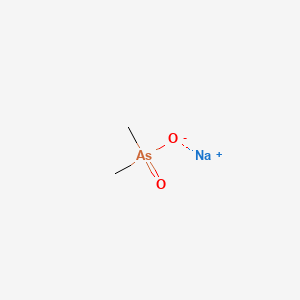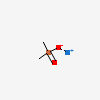Sodium cacodylate
- SODIUM CACODYLATE
- Sodium dimethylarsinate
- 124-65-2
- Arsicodile
- Cacodylic acid sodium salt
- Create:2005-07-19
- Modify:2025-01-11
 Cacodylic Acid (annotation moved to).
Cacodylic Acid (annotation moved to).
- SODIUM CACODYLATE
- Sodium dimethylarsinate
- 124-65-2
- Arsicodile
- Cacodylic acid sodium salt
- Dimethylarsinic acid sodium salt
- Alkarsodyl
- Sodium dimethylarsonate
- Sodium dimethyl arsinate
- Arsecodile
- Arsycodile
- Bolate
- Cacodylate de sodium
- Bolls-eye
- Sodium salt of cacodylic acid
- ((Dimethylarsino)oxy)sodium As-oxide
- ((Dimethylarsino)oxy)sodium-As-oxide
- Rad-E-Cate 25
- Hydroxydimethylarsine oxide, sodium salt
- CHEBI:62956
- UN1688
- Arsinic acid, As,As-dimethyl-, sodium salt (1:1)
- OC4237N148
- Arsysodila
- Chemaid
- Bophy
- Dutch-treat
- Rad-E-Cate
- Sodium dimethylarsinate (0.1M buffer soln., pH 7.0)
- Caswell No. 133A
- Rad-E-Cate 16
- Kakodylan dodny
- Kakodylan dodny [Czech]
- Dimethylarsinat sodny [Czech]
- Dimethylarsinat sodny
- Cacodylate de sodium [French]
- NSC-1910
- CCRIS 7929
- HSDB 731
- Sodium cacodylate [NF]
- NSC 1910
- EINECS 204-708-2
- Arsinic acid, dimethyl-, sodium salt
- EPA Pesticide Chemical Code 012502
- Broadsides
- Sodium, ((dimethylarsino)oxy)-, As-oxide
- Arsine oxide, hydroxydimethyl-, sodium salt
- UNII-OC4237N148
- Cacodylic acid sodium salt hydrate
- sodium;dimethylarsinate
- sodium dimethyl arsonide
- Arsine oxide, dimethylhydroxy-, sodium salt
- SCHEMBL43010
- SODIUM CACODYLATE [MI]
- CHEMBL2079844
- DTXSID3034408
- SODIUM CACODYLATE [HSDB]
- SODIUM CACODYLATE [MART.]
- SODIUM CACODYLATE [WHO-DD]
- AKOS016010300
- Sodium cacodylate [UN1688] [Poison]
- NS00079363
- Q26840782
 Cacodylic Acid (annotation moved to)
Cacodylic Acid (annotation moved to)· Highly toxic, may be fatal if inhaled, ingested or absorbed through skin.
· Contact with molten substance may cause severe burns to skin and eyes.
· Avoid any skin contact.
· Fire may produce irritating, corrosive and/or toxic gases.
· Runoff from fire control or dilution water may be corrosive and/or toxic and cause environmental contamination.
· Combustible material: may burn but does not ignite readily.
· Containers may explode when heated.
· Those substances designated with a (P) may polymerize explosively when heated or involved in a fire.
· Runoff may pollute waterways.
· Substance may be transported in a molten form.
General First Aid:
· Call 911 or emergency medical service.
· Ensure that medical personnel are aware of the material(s) involved, take precautions to protect themselves and avoid contamination.
· Move victim to fresh air if it can be done safely.
· Administer oxygen if breathing is difficult.
· If victim is not breathing:
-- DO NOT perform mouth-to-mouth resuscitation; the victim may have ingestedor inhaled the substance.
-- If equipped and pulse detected, wash face and mouth, then give artificial respiration using a proper respiratory medical device (bag-valve mask, pocket mask equipped with a one-way valve or other device).
-- If no pulse detected or no respiratory medical device available, provide continuouscompressions. Conduct a pulse check every two minutes or monitor for any signs of spontaneous respirations.
· Remove and isolate contaminated clothing and shoes.
· For minor skin contact, avoid spreading material on unaffected skin.
· In case of contact with substance, remove immediately by flushing skin or eyes with running water for at least 20 minutes.
· For severe burns, immediate medical attention is required.
· Effects of exposure (inhalation, ingestion, or skin contact) to substance may be delayed.
· Keep victim calm and warm.
· Keep victim under observation.
· For further assistance, contact your local Poison Control Center.
· Note: Basic Life Support (BLS) and Advanced Life Support (ALS) should be done by trained professionals.
Specific First Aid:
· Removal of solidified molten material from skin requires medical assistance.
In Canada, an Emergency Response Assistance Plan (ERAP) may be required for this product. Please consult the shipping paper and/or the "ERAP" section.
· CALL 911. Then call emergency response telephone number on shipping paper. If shipping paper not available or no answer, refer to appropriate telephone number listed on the inside back cover.
· Keep unauthorized personnel away.
· Stay upwind, uphill and/or upstream.
· ELIMINATE all ignition sources (no smoking, flares, sparks or flames) from immediate area.
· Do not touch damaged containers or spilled material unless wearing appropriate protective clothing.
· Stop leak if you can do it without risk.
· Prevent entry into waterways, sewers, basements or confined areas.
· Cover with plastic sheet to prevent spreading.
· Absorb or cover with dry earth, sand or other non-combustible material and transfer to containers.
· DO NOT GET WATER INSIDE CONTAINERS.
Immediate precautionary measure
· Isolate spill or leak area in all directions for at least 50 meters (150 feet) for liquids and at least 25 meters (75 feet) for solids.
Spill
· For highlighted materials: see Table 1 - Initial Isolation and Protective Action Distances.
· For non-highlighted materials: increase the immediate precautionary measure distance, in the downwind direction, as necessary.
Fire
· If tank, rail tank car or highway tank is involved in a fire, ISOLATE for 800 meters (1/2 mile) in all directions; also, consider initial evacuation for 800 meters (1/2 mile) in all directions.
· Wear positive pressure self-contained breathing apparatus (SCBA).
· Wear chemical protective clothing that is specifically recommended by the manufacturer when there is NO RISK OF FIRE.
· Structural firefighters' protective clothing provides thermal protection but only limited chemical protection.
Small Fire
· Dry chemical, CO2 or water spray.
Large Fire
· Water spray, fog or regular foam.
· If it can be done safely, move undamaged containers away from the area around the fire.
· Dike runoff from fire control for later disposal.
· Avoid aiming straight or solid streams directly onto the product.
Fire Involving Tanks, Rail Tank Cars or Highway Tanks
· Fight fire from maximum distance or use unmanned master stream devices or monitor nozzles.
· Do not get water inside containers.
· Cool containers with flooding quantities of water until well after fire is out.
· Withdraw immediately in case of rising sound from venting safety devices or discoloration of tank.
· ALWAYS stay away from tanks in direct contact with flames.
· For massive fire, use unmanned master stream devices or monitor nozzles; if this is impossible, withdraw from area and let fire burn.
Patents are available for this chemical structure:
https://patentscope.wipo.int/search/en/result.jsf?inchikey=IHQKEDIOMGYHEB-UHFFFAOYSA-M
- ChEBISodium dimethylarsinatehttps://www.ebi.ac.uk/chebi/searchId.do?chebiId=CHEBI:62956
- ChEMBLLICENSEAccess to the web interface of ChEMBL is made under the EBI's Terms of Use (http://www.ebi.ac.uk/Information/termsofuse.html). The ChEMBL data is made available on a Creative Commons Attribution-Share Alike 3.0 Unported License (http://creativecommons.org/licenses/by-sa/3.0/).http://www.ebi.ac.uk/Information/termsofuse.html
- ChemIDplusSodium cacodylate [NF]https://pubchem.ncbi.nlm.nih.gov/substance/?source=chemidplus&sourceid=0000124652ChemIDplus Chemical Information Classificationhttps://pubchem.ncbi.nlm.nih.gov/source/ChemIDplus
- EPA DSSToxCacodylic acid, sodium salthttps://comptox.epa.gov/dashboard/DTXSID3034408CompTox Chemicals Dashboard Chemical Listshttps://comptox.epa.gov/dashboard/chemical-lists/
- FDA Global Substance Registration System (GSRS)LICENSEUnless otherwise noted, the contents of the FDA website (www.fda.gov), both text and graphics, are not copyrighted. They are in the public domain and may be republished, reprinted and otherwise used freely by anyone without the need to obtain permission from FDA. Credit to the U.S. Food and Drug Administration as the source is appreciated but not required.https://www.fda.gov/about-fda/about-website/website-policies#linkingSODIUM CACODYLATEhttps://gsrs.ncats.nih.gov/ginas/app/beta/substances/OC4237N148
- Risk Assessment Information System (RAIS)LICENSEThis work has been sponsored by the U.S. Department of Energy (DOE), Office of Environmental Management, Oak Ridge Operations (ORO) Office through a joint collaboration between United Cleanup Oak Ridge LLC (UCOR), Oak Ridge National Laboratory (ORNL), and The University of Tennessee, Ecology and Evolutionary Biology, The Institute for Environmental Modeling (TIEM). All rights reserved.https://rais.ornl.gov/Sodium cacodylatehttps://rais.ornl.gov/cgi-bin/tools/TOX_search
- Emergency Response Guidebook (ERG)Sodium cacodylatehttps://pubchem.ncbi.nlm.nih.gov/erg/
- EPA Pesticide Ecotoxicity Database
- EU Pesticides Database
- Japan Chemical Substance Dictionary (Nikkaji)
- NCI Thesaurus (NCIt)LICENSEUnless otherwise indicated, all text within NCI products is free of copyright and may be reused without our permission. Credit the National Cancer Institute as the source.https://www.cancer.gov/policies/copyright-reuseNCI Thesaurushttps://ncit.nci.nih.gov
- Springer Nature
- Wikidatasodium cacodylatehttps://www.wikidata.org/wiki/Q26840782
- PubChem
- GHS Classification (UNECE)GHS Classification Treehttp://www.unece.org/trans/danger/publi/ghs/ghs_welcome_e.html
- CAMEO ChemicalsLICENSECAMEO Chemicals and all other CAMEO products are available at no charge to those organizations and individuals (recipients) responsible for the safe handling of chemicals. However, some of the chemical data itself is subject to the copyright restrictions of the companies or organizations that provided the data.https://cameochemicals.noaa.gov/help/reference/terms_and_conditions.htm?d_f=falseCAMEO Chemical Reactivity Classificationhttps://cameochemicals.noaa.gov/browse/react
- NORMAN Suspect List ExchangeLICENSEData: CC-BY 4.0; Code (hosted by ECI, LCSB): Artistic-2.0https://creativecommons.org/licenses/by/4.0/NORMAN Suspect List Exchange Classificationhttps://www.norman-network.com/nds/SLE/
- Consumer Product Information Database (CPID)LICENSECopyright (c) 2024 DeLima Associates. All rights reserved. Unless otherwise indicated, all materials from CPID are copyrighted by DeLima Associates. No part of these materials, either text or image may be used for any purpose other than for personal use. Therefore, reproduction, modification, storage in a retrieval system or retransmission, in any form or by any means, electronic, mechanical or otherwise, for reasons other than personal use, is strictly prohibited without prior written permission.https://www.whatsinproducts.com/contents/view/1/6Consumer Products Category Classificationhttps://www.whatsinproducts.com/
- EPA Substance Registry ServicesEPA SRS List Classificationhttps://sor.epa.gov/sor_internet/registry/substreg/LandingPage.do
- EPA Chemicals under the TSCAEPA TSCA Classificationhttps://www.epa.gov/tsca-inventory
- MolGenieMolGenie Organic Chemistry Ontologyhttps://github.com/MolGenie/ontology/
- PATENTSCOPE (WIPO)SID 403405787https://pubchem.ncbi.nlm.nih.gov/substance/403405787

 CID 5360545 (Sodium)
CID 5360545 (Sodium)